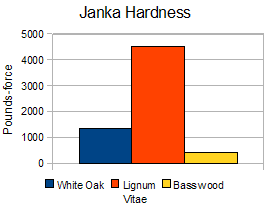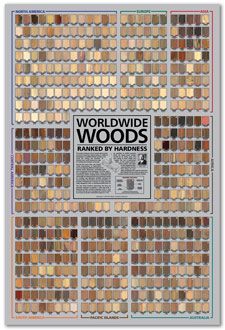This number is incredibly useful in directly determining how well a wood will withstand dents, dings, and wear—as well as indirectly predicting the difficulty in nailing, screwing, sanding, or sawing a given wood species.

The actual number listed in the wood profile is the amount of pounds-force (lbf) or newtons (N) required to imbed a .444″ (11.28 mm) diameter steel ball into the wood to half the ball’s diameter. This number is given for wood that has been dried to a 12% moisture content, unless otherwise noted.
For reference, white oak has a Janka hardness of 1,350 lbf (5,990 N), while the super-hard lignum vitae has a hardness of an astounding 4,390 lbf (19,510 N). (Who could imagine a wood species that is over three times harder than white oak?) On the lower end of the spectrum, basswood has a hardness of around 410 lbf (1,820 N).

Also, in some instances (where noted), I’ve estimated the Janka hardness value using equations that use the wood’s basic specific gravity, as found in the paper, “Estimating Janka Hardness from Specific Gravity for Tropical and Temperate Species.”
Related Articles:
Are you an aspiring wood nerd?


Please get a sample of Borneo Ironwood (Belian). The Tested Janka hardness is around 3800 pound per sq inch. This wood is among, if not, the longest lasting wood in the world. Easily goes beyond 50 years on ground contact, and its not uncommon to hear this wood to last over 100 years outside, untreated. We have evidence of this wood, used as a coffin by people, hundreds of years ago, and the coffins still in good shape, and Carbon dated to at least 700 years!
I’m searching the internet for a club weapon replica from the Zelda game and can’t find it or anything like it. So, I’m researching to find the denser lighter woods. I’m willing to spend $300, but know I can get much cheaper like beech wood. I plan to whittle and use an electric wood burner and to oil it into a reasonable gift. Can you tell me how to best start the research side? That ‘would’ be amazing of you. Thanks so much for you’re time.
Here’s a filter of all the light colored woods, sorted from heaviest to lightest. Though some of them I think you’ll have trouble finding commercially. https://www.wood-database.com/wood-filter/?fwp_color=a6bc2d12dbd5b61142f04f9209121742&fwp_sort=weight
Hi do you know the name of this wood?is it from brazilia?
They are knots of Brazilian pine know as “Pino Paraná” or “Pino Brasil”. They are know as “clavo de pino”. You can see pics and more details here: https://www.wood-database.com/parana-pine
The flame pattern in the grain and colors – it could be a species of pine from the Parana state in the south of Brasil.
Furniture restorer for 25 years in London. I live din Brasil for 18 months.
Hi,
Do you have a filter where you can rank a select amount of woods by hardness?
Thank you,
Jade
https://www.wood-database.com/wood-filter/?fwp_sort=hardness
I’ve worked a lot of Yew wood and although its a softwood it can seriously damage many hardwoods. Small sharp pieces were used by Vikings as nails to secure the longboat planks to the stem and stern, as they resisted saltwater better than steel (which the Vikings also developed for tolls and weaponry). So although a softwood, it can be driven through hardwood!. It is quite beautful, variagated, striking and extremely long lasting. It doesnt rot too easily either. We had 25mm quarter sawn planks laid up for 30 years in a country garage and there was no decay apart… Read more »
Has anyone janka tested rhododendron?
The USDA’s technical bulletin 479 tested Rhododendron maximum and came up with a side hardness of 860 lbf in the green, undried state, but no info on dried wood. For comparison, in the document the 860 lbf value was about the same as the green hardness of red oak. https://naldc.nal.usda.gov/download/CAT86200473/PDF
Weird. I have worked with rhododendron wood from my woods and it is much harder than every wood I have worked with, including olive.
Out of curiosity do you know why they use that size of ball 0.444″ instead of say 0.5″
Yes, the circular indentation is equal to 1 square centimeter.
Anyone knows how “Tristaniopsis Decorticata” compare to the hardest trees in the world?
It’s super dense and black like ebony but a lot heavier.
I found a reference for this wood at 4260 lbf Janka hardness.
wow Thanks! ? are you collecting wood samples?
Yes, do you have anything for trade? See here: https://www.wood-database.com/trade/
I may have wood samples for free. I would like to see you complete your collection. Do you have an email?
I just sent you an email. Thanks
Great article, thank you. I was given some Picoyo Maderas and it appears to be extremely dense and resinous. Has anyone done Janka hardness test on that material? If so or even if not, how could I acquire the information?
Do you have a scientific name for this wood? I am not familiar with that name Picoyo Maderas.
No, sorry. I can tell you it is a nut tree from Chile that the nuts are apparently very popular there.
The picoyo is the wood junction between the branch and the trunk of the tree of the Araucaria araucana, it is very high density wood. When the tree dies it degrades and they are exposed. Araucaria araucana is the hardiest species in the conifer genus Araucaria. It is a slow-growing and long-lived species, being able to exceed 1000 years.
I sent you an email, but here is the short version. I wonder if you could test ginkgo biloba for its janka rating. At almost 270 million years old, I’m surprised it’s not listed anywhere. There is no tree that has stood through glacier shifts, continental shifts, ice ages, dinosaurs, and even mankind. Definitely a worthy wood to be catalogued.
Based on the description I found at the address below, I suspect it’s not as hard as others.
https://www.canadianwoodworking.com/woods-know-ginkgo
I was wondering your thoughts on a butcher block counter. Where would you draw the line for the hardness? (Nobody likes dings and dents all over their counters) Also, when will this become available again?
So, this would measure the ability of a wood be bulletproof?
No, just the LBF needed to Imbed the .444 inch steel ball 11.28 millimeters into the wood
The Janka test measures the force (LBF) required to embed the .444″ ball halfway into the wood. So that would be a distance of .222″, or 5.64 mm.
What size pieces are needed to run a Janka test and where can these tests be carried out?
Well, the two standbys are White Ash and Hard Maple, so I would try to stay in that ballpark. Roughly, I would try to stay around the 1200 lbf mark. But as you said, there are a lot of other properties that are more important than hardness, one of which is shock resistance.
We are install solid wood/sand poly floor in a new home with a full basement, what vapor barrier should we use
I had a question – At what measure of hardness is a wood classified as a hardwood or softwood? Is there a specific threshold?
Hardwood and softwood labels are somewhat misleading, and have nothing actually to do with the hardness of the wood, but rather to botany. Angiosperms are referred to as hardwoods, while gymnosperms (aka conifers) are softwoods. Technically Balsa is a hardwood, though it’s the softest wood around, and some softwoods can be somewhat hard. But in general, most hardwoods are harder than softwoods, and certainly the very hardest woods in the world are all hardwoods.
That’s a great explanation Ejmeier. Thank you for clarifying. I had a query with regards to Douglas Fir wood. It has a Janka hardness of 660 lb which technically makes it a softwood but a lot of people vouch for its durability. So just wanted to check with you too..thoughts?
I suppose it depends on what you’re comparing it to. Douglas fir is probably above average in hardness for a softwood, but I’d say that it was by no means as tough as something like oak or hard maple. But going back to your original question in terms of a hardness threshold, it depends on the application, but for me, I’d look for at least a Janka hardness of say around 800 or 900 lbf for most objects that will get handled, etc., and closer to 1500 lbf for things like worktops or flooring.
Douglas fir works out great for wood working benches. Having to hard of a surface on your bench can cause marks in your work. It is a question of whether you want the marks to show up on your new piece of work or on the work bench. Douglas fir provided a good stable surface to work on.
Except lets say taxus baccata!
Im 70 converting from being a retired Tool Maker to some kind of wood worker. All of this is very interesting. some of this is like comparing austenitic to martensitic. Then you run into nickel its austenitic but acts like martensitic in many ways. I know Rockwell. I will learn Janka. I have measured Nickel hardness in Newtons. There must be a lot of woods harder than Nickel. If my teachings come to mind Hardness is defined by resistance to abrasion. This form of testing must equate to pounds of pressure to certain depth of penetration. Thanks Rich
“I have measured Nickel hardness in Newtons. There must be a lot of woods harder than Nickel”…
Interesting idea, Rich! You kind of baited a “hook” for those of us that love to work with a lot of different materials (metal, stone, wood, bone, horn, etc).
So,OK: Now that you’ve had a couple years to ease into wood, have you found an answer?
–Thom